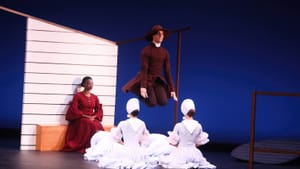Stay in the Loop
BSR publishes on a weekly schedule, with an email newsletter every Wednesday and Thursday morning. There’s no paywall, and subscribing is always free.
A cracking good Martha Graham
NextMove Dance presents Martha Graham Dance Company

NextMove Dance invited the Martha Graham Dance Company (MGDC) to be a part of their 46th season, giving Philadelphia dance lovers the opportunity to view the internationally renowned and much-beloved ensemble. Reviving Graham classics, such as the ballet Appalachian Spring, and offering refreshing takes by contemporary choreographers in Lamentation Variations, MGDC reminds us that their founder’s work maintains a remarkable balance between timeless and timely.
Expectations and discoveries
But it is a given that Graham’s work is spectacular and that the dancers who bring her choreography to life are exquisite movers. We expect graceful bodies, thrilling visuals, and an intimate partnership between the music, design, and movement. When a company revamps tried and true classics, it becomes an emotional and intellectual exercise to find connecting threads. What do Martha Graham dances mean to us in 2016?
The evening began with Graham’s 1946 Dark Meadow. The piece was reconfigured into Dark Meadow Suites, a compilation of the abstract choreography Graham created to showcase her ensemble’s chorus. In it, sunrise of heated oranges and yellows bloomed up to reveal a stage of proud, crane-like women breezing to cellos and violins and then firmly slapping their thighs and pounding the earth with their feet.
When the men arrived, it was clear they were partners to these women — not masters. Instead of female dancers becoming props to showcase the men’s strength, they worked together to create a single image: men planting to the ground to hold the women’s feet as they leaned forward and swung, like flags in the wind. Graham’s choreography celebrated the power of women long before it was acceptable to do so.
Color blindness
Next was Errand into the Maze (1947), tweaked after Hurricane Sandy damaged its original set and costumes. This new version had no set, and instead used a single length of white fabric to create the labyrinth housing the mythical Minotaur. Continuing feminist themes, Graham put Ariadne into the maze to confront the Minotaur instead of Theseus, the famed hero who destroys the beast. While it is exciting to see a woman take charge in a story typically applauding masculine heroism, the dance’s pairing caught my attention.
Ariadne was danced by a white woman (lithe, athletic Laurel Dalley Smith). The Minotaur terrorizing her was a dancer of color (a powerful Ari Mayzick). Ariadne flung herself away and toward a monster with the capacity for superhuman leaps (Mayzick is a dancer not bound by gravity). She battles with and eventually destroys the beast, and escapes towards victory.
Color-blind casting is an admirable endeavor, but it was impossible for me to ignore the decisions here. I was troubled by the “up with white feminism” motif, because the other subconscious message demonized a performer of color.
Grief paired with optimism
Things soared once more with Lamentation Variations, a project that began in 2007 to commemorate the anniversary of 9/11. MGDC commissioned several choreographers to view and respond to a video of Graham’s famous solo on grief, Lamentation (1930). This season Bulareyaung Pagarlava, Richard Move, and Larry Keigwin took on the task of interpreting Graham’s moving exploration of mourning, resulting in three pieces examining the isolation, devastation, and impossible hope associated with death and grieving.
A dancer’s arms stretched towards light while her body bent backwards to the past she left behind. A single female was held upside down and marched away by her male cohorts. Crowds wilted and collapsed to the ground while seeking the comforting arms of another. The audience emitted a cathartic exhale when the lights were brought up for intermission.
When we settled in for the beginning of Appalachian Spring, the woman next to me said, “I think I’m going to cry.” This was the piece people came to see; it’s the big one. The ballet was dreamed up by Graham in 1944 in an effort to rally the country as World War II was coming to a close. Together with the music of Aaron Copland (who won the Pulitzer Prize for his composition), Isamu Noguchi’s iconic Shaker-inspired set, and Graham’s bright choreography of graceful do-si-dos and open-hearted square dance steps, the ballet is a call back to simpler times and good ol’ fashioned American optimism. It may seem hokey, but 2016 could use a dose of the pure hopefulness that Appalachian Springs delivered.
For Camille Bacon-Smith's review of this show, click here.
What, When, Where
NextMove Dance presents Martha Graham Dance Company. November 3 through November 6, 2016 at the Prince Theater, 1412 Chestnut Street, Philadelphia. (215) 422-4580 or princetheater.org.
Sign up for our newsletter
All of the week's new articles, all in one place. Sign up for the free weekly BSR newsletters, and don't miss a conversation.

 Alix Rosenfeld
Alix Rosenfeld